#alexie holland
Text
New Friends! ◇♤♡

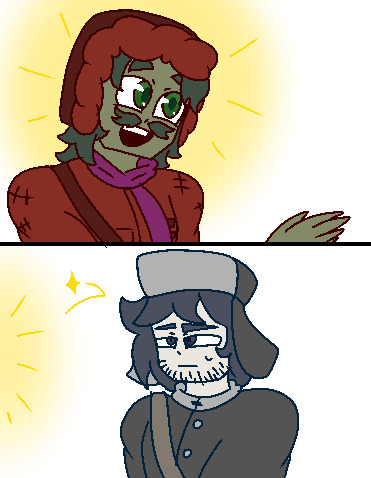
Alexie greets some of the newcomers to the border! @conradforrest 's Inspector Olek and @l0caladm1n 's Mykhaylo!
Ur guy's OCs r pretty neat along with the other art ya do, always happy to see ppl enjoying the game despite how niché it is!!
And a little bit of dialogue 4 funsies!
Alexie: Hello there, pleased to see one of you Paradizna fellows around here! I'm Alexie, Chief of Border Security!
Mykhaylo: Ah- H-Hello, I am from the MOI's Paradizna Division. Here's my information, I-I am here to meet with Mr. Vonel?
Alexie: [Alexie looks over his MOI badge] Nice to meet you, Miss Smirnoy! Right this way and I'll lead you to him! Oh, have I mentioned that you remind me of a friend I know?
~~~~~~~~~~~~
Alexie: Hello, Hello! You must be the new inspector, I'm so happy to meet you!!
Olek: Hey There, Nice to meet you too. I'm Olek.
Alexie: I'm Alexie! The chief of security! We'll do everything we can to keep you safe! You know, my best friend used to work here before you, so I'll be able to guide you through things with what he taught me!
Olek: Okay. you are very energetic..
Alexie: Did you say something?
Olek: Ah, nothing, continue.
12 notes
·
View notes
Text
Current Project ♤♡
Heya! This is a masterpost for a chapter series I'm currently working on solo, I've been working on it since April 2021 (2 years now!)
The name of it is "Paper's, Please: Hope or Glory"! It's an AU I made based off of the game, with minor alterations, new characters and deeper lore!
(Please Reblog so I can get this to more ppl!)
What is Hope or Glory about?
Hope or Glory will be mostly spoken from the perspective of 3 characters, Inspector, Manya Holland and Alexie Holland.
This is not only a retelling of the game, but a new story following a past incident with the Inspector's father and the Holland siblings, Nadja and Rostislav.
Meeting the Characters!

Our main man, Inspector! He's an introverted guy who's pretty plain on his own. He got his job as border inspector for the sake of his family, he lives with his wife, son, mother in law and uncle.
Though he's introverted for a slight reason, he's been trying to solve his Father's criminal case for years. The government has claimed to have solved this already but he believes there is more and will do as much as possible to prove his Father innocent.

Alexie, the brightest sunshine in Grestin and proud childhood friend of Inspector!
He's the Chief of Border Security who is surprisingly kind for his status! His father, Anatolli Holland, was a First Lieutenant in Arstotzka's Marine Forces and died at the time Alexie was born. His mother and siblings had moved to the United Fed when he was 20. But for the sake of Inspector, he stayed behind and kept him company.

Manya, a strange woman who has many secrets. She's the only daughter of Rostislav Holland, but after her father's death she was raised by Danic Lorun in Republia. She now works as an expert investigator in Arstotzka, catching criminals and solving other's mysteries. But what about herself? Is she just acting weird for the sake of it or is she hiding something behind closed doors?
What will be different?
There's quite a bit of things that are different from the game's canon, both minor additions like adding last names and new background characters to big changes like diving into Arstotzka's Economy and History and making minor characters crucial to the new plot!
Speaking of which, I've added a whole new faction, which has been renamed to:

фиолетовый капитал (fioletovyy kapital)
They're a group that not only strives for freedom, but for equity and peace, half of its team works on protests and donations in the day, but sabatoge the rich and greedy at night. Their symbol is a violet and they usually leave the petals of the flower behind when they complete a mission.
How can I read this?
While I don't have an AO3 yet, I'm currently posting the chapters on my Art Tumblr! And I'll update this post for links to the newest chapters!
Chapter 1
Chapter 2
Chapter 3
Chapter 4 (Coming Soon!)
Thank you so much for reading! Again, please Reblog so I can get this around, I'm working really hard on it!
That's all I got for now so I'll cya later!
8 notes
·
View notes
Text
"It's just a little cowlick, that's all"
#hehe#imho#imho the show#alexis p. bevels#darby lynne cartwright#aunty chan#drag race holland#envy peru#rpdr#rupaul's drag race#drag#video uploading remains a mess i see
33 notes
·
View notes
Text
hullomoon's femslash february round-up
it may almost be april but there's always time to celebrate wlw works!
podfics
[podfic] why do i have to pretend? | Schitt's Creek | Alexis Rose/Stevie Budd | 14:14
Alexis and Stevie are roommates and friends, nothing more. At least, that used to be true. Alexis isn’t sure when things changed, but lately she suspects that she might be feeling things for her roommate that go beyond friendship.
[podfic] Stars | The Adventure Zone | Amber Gris/Oksana Kodeira | 04:29
Amber tilts her head towards the sky and squints. “More stars than I remember.”
“Different planet.”
She shrugs. “Fair enough.”
[podfic] Card Catalogue | A League of Their Own (TV) | Carson Shaw/Greta Gill | 23:18
How to tell someone you love them, without using those words.
[podfic] this story that we found ourselves in | Stranger Things | Nancy Wheeler/Robin Buckley | 02:29:00
Three days later, they find a magazine on their doorstep. Steve flips it open to a picture of him kissing her cheek beneath tall, bold letters:
FANTASY ROMANCE ALIVE AND WELL
Stuck to the page is a crinkled post-it note and Jonathan’s handwriting: thanks for the tip—wishing you both the best.
Robin sinks into the kitchen chair. It’s official. She’s in a relationship with Steve Harrington.
or, the Robin-centric celebrity fake dating au
fics
breathless and on your lips | Stranger Things | Nancy Wheeler/Robin Buckley | Mature | 775
Tonight, Robin has to prove herself. She gets more than what she expected
lookin’ in the mirror at me, my god | Stranger Things | Chrissy Cunningham/Heather Holloway | Explicit | 707
After practice, Chrissy wants to give Heather a little attention
from me to you | Stranger Things | Eleven/Max Mayfield | 705
Letters between Max and Eleven during a world-ending apocalypse
to have and to hold | Stranger Things | Barb Holland/Nancy Wheeler | Explicit | 777
Nancy dreams of Barb
#hullomoon podfics#hullomoon writes#schitts creek#taz ethersea#stranger things#alexis rose/stevie budd#amber gris/oksana kodeira#ronance#elmax#chrissy cunningham/heather holloway#barb holland/nancy wheeler#a league of their own#carson shaw/greta gill
3 notes
·
View notes
Text
Duffer Brothers have a Master Class about writing characters for the sole purpose of killing them off
43 notes
·
View notes
Conversation
Updated list of Stranger Things characters that we loved instantly only to have them cruelly taken away from us
Season 1: Barb and Benny
Season 2: Bob
Season 3: Alexis
Season 4: Eddie
#stranger things#netflix#parallels#eddie munson#barbara holland#bob newby#bennie#alexis#the fallen#r.i.p.
21 notes
·
View notes
Text
NOT GONNA GET ATTACHED TO ANY NEW CHARACTERS ANYMORE. NOT EVEN VICKIE. OR ARGYLE. DON'T KNOW WHO THEY ARE GONNA TAKE AWAY FROM ME ANYMORE FUCK 😭😭😭
#stranger things#stranger things 4#stranger things spoilers#alexie#eddie munson#bob newby#barbara holland#billy hargrove#max mayfield#I HONESTLY CAN'T TAKE THE PAIN ANYMORE#stranger things season 4#stranger things season 4 volume 2#im still traumatized
22 notes
·
View notes
Text

stranger things house's
Hufflepuff: El, Will, Barb, Steve, Argyle
Gryffindor: Max, Lucas, Joyce, Hopper, Robin, Suzie
Ravenclaw: Dustin, Nancy, Jonathan, Murray, Erica, Alexi
Slytherin: Mike, Eddie, Lonnie, Billy, Yuri, Henry
what other fandoms should i do this for? you can suggest fandoms for this kind of things. :D
#will byers#el hopper#jonathan byers#dustin henderson#nancy wheeler#lucas sinclair#jim hopper#max mayfield#brenner#harry potter#billy hargrove#murray bauman#barb holland#erica sinclair#erica girl boss#stranger things#alexi stranger things#joyce byers#argyle#steve harrington#jopper#byler#elmax#platonic lumax
10 notes
·
View notes
Text
youtube
Hot Chip - Eleanor • Later with Jools Holland (2022)
#hot chip#freakout/release#later with jools holland#mine#alexis’ little hoop earring. gender king#with the pink hair too#god i miss the brixton show sooo bad
1 note
·
View note
Text
How do I get cast in Stranger Things season 5 as the brand new, extremely likable, fan favorite character who dies for literally no reason before the season is over??
Who do I send my head shot and resume to for that inevitable role??
1 note
·
View note
Text
AA Duo ♡♤
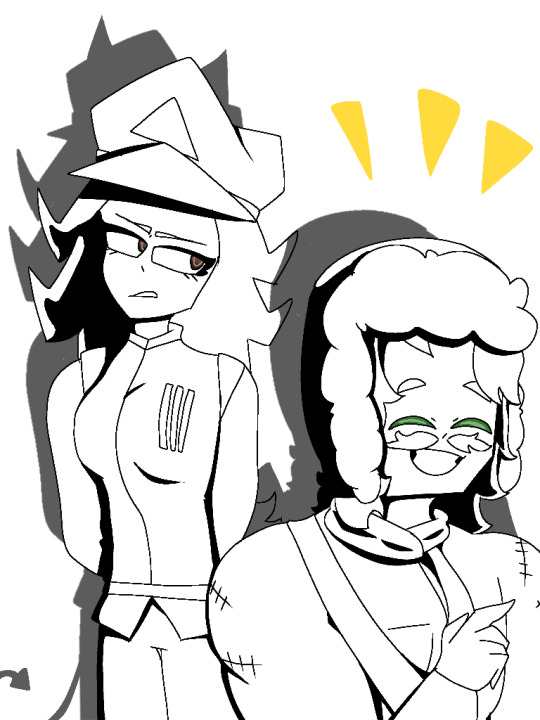
Drew @swan-swanno 's Askali with Alexie again bc she's the best worst women in Arstotzka <3 I decided to go with a colorless picture this time with hard lighting!


Also bonus memes, Alexie Supports women's rights AND wrongs
8 notes
·
View notes
Text
https://sandra-406.etuoq.top/gp/ykbSOgL
#wigetta#alt model#five hargreeves#te extraño#submisive sissy#rococo#animal friends#ginny weasley#solar system#网红#free! iwatobi swim club#ps3
124 notes
·
View notes
Text
PBS FEMENINOS POR EDAD
Hola personitas. Venimos con un aporte que nos ha costado un tiempito reunir. Es posible que algunos PB tengan 1 añito más de lo que pone, porque igual cumplieron recién. Esperamos les guste ^^
-14
Evie Gardner (9)
Charlie Townsend (10)
Alexis & Ava McClure (10)
Everleight Souta (10)
Anniston Price (11)
Sienna Fizz (11)
Willow Morgan (11)
Blayke Busby (12)
Maya Le Clark (12)
Brooklynn Prince (13)
Kingston Foster (13)
Trinity Valenzuela (13)
14-17
River Woollard (14)
Isla Stanford (14)
Nuala Chee (14)
Shiloh Nelson (14)
Raegan Revord (15)
Sarah Dorothy Little (15)
Scarlett Estevez (15)
Cailey Fleming (16)
Indi Star (16)
Nicolette Durazzo (16)
Pressley Hosbach (16)
Priah Ferguson (16)
Havanna Winter (17)
Kristina Pimenova (17)
Mabel Chee (17)
McKenna Grace (17)
Ruby Rose Turner (17)
18-23
Dafne Keen (18)
Grace Vanderwaal (19)
Lily Chee (19)
Loreto Peralta (19)
Millie Bobby Brown (19)
Sissy Sheridan (19)
Anna CathCart (20)
Maddie Ziegler (20)
AmyBeth MnNulty (21)
Ava Michelle (21)
Billie Eilish (21)
Kaia Gerber (21)
Rowan Blanchard (21)
Sadie Sink (21)
Sophia Lillis (21)
Cara Taylor (22)
Iris Law (22)
Mackenzie Foy (22)
Meghan Roche (22)
Isabela Moner (22)
Yael Yurman (22)
Ester Expósito (23)
Kiernan Shipka (23)
24-29
Aitana Ocaña (24)
Amandla Stenberg (24)
Brec Bassinger (24)
Fran Summers (24)
Joey King (24)
Lani Baker (24)
Lily-Rose Depp (24)
Paris Berelc (24)
Sabrina Carpenter (24)
Ariel Winter (25)
Bella Thorne (25)
Elle Fanning (25)
Georgina Amorós (25)
Luna Bijl (25)
Maya Hawke (25)
Peyton List (25)
Sydney Sweeney (25)
Vittoria Ceretti (25)
Bella Hadid (26)
Camila Cabello (26)
Chloë Grace Moretz (26)
Ella Purnel (26)
Grace Elizabeth (26)
Hailee Steinfeld (26)
Jean Campbell (26)
Kylie Jenner (26)
Lana Condor (26)
Lili Reinhart (26)
Lisa Manoban (26)
Madelaine Arthur (26)
Maisie Williams (26)
Momo Hirai (26)
Odeya Rush (26)
Olivia Holt (26)
Pyper America Smith (26)
Shannon Purser (26)
Valentina Zenere (26)
Zendaya(26)
Abigail Breslin (27)
Anya Taylor-Joy (27)
Courtney Eaton (27)
Dove Cameron (27)
Dua Lipa (27)
Jennie Kim (27)
Karen Méndez (27)
Katherine McNamara (27)
Kelianne Stankus (27)
Kelly Berglund (27)
Kendall Jenner (27)
Lydia Graham (27)
María Pedraza (27)
Sarah Gilman (27)
Sophie Turner (27)
Birgit Kos (28)
Danna Paola (28)
Georgia Hirst (28)
Gigi Hadid (28)
Jisoo Kim (28)
Melanie Martinez (28)
Natalia Dyer (28)
Nicola Peltz (28)
Haley Lu Richardson (28)
Halsey (28)
Liana Liberato (28)
Tiera Skovbye (28)
Adele Exarchopoulos (29)
AnnaSophia Robb (29)
Barbara Palvin (29)
Camila Mendes (29)
Claudia Salas (29)
Cleo Massey (29)
Dakota Fanning (29)
Emilija Baranac (29)
India Eisley (29)
Julia Garner (29)
Letitia Wright (29)
Luma Grothe (29)
Madelaine Petsch (29)
Meghan Trainor (29)
Mina El Hammani (29)
Ritu Arya (29)
Saoirse Ronan (29)
Taissa Farmiga (29)
30-39
Alycia Debnam-Carey (30)
Ariana Grande (30)
Charlotte McKinney (30)
Debby Ryan (30)
Elizabeth Gillies (30)
Irina Isasia (30)
Linnea Berthelsen (30)
Miley Cyrus (30)
Naomi Scott (30)
Sofia Carson (30)
Cara Delevigne (31)
Demi Lovato (31)
Gaia Weiss (31)
Grace Phipps (31)
Josefin Asplund (31)
Karlie Kloss (31)
Kate Upton (31)
Kaya Scodelario (31)
Lali Espósito (31)
Madeline Brewer (31)
Mimi Doblas (31)
Selena Gomez (31)
Shailene Woodley (31)
Vanessa Morgan (31)
Emma Roberts (32)
Jasmine Tookes (32)
Kiko Mizuhara (32)
Malese Jow (32)
Sarah Hyland (32)
Willa Holland (32)
Ashley Benson (33)
Brie Larson (33)
Daveigh Chase (33)
Emma Watson (33)
Indiana Evans (33)
Jane Levy (33)
Jennifer Lawrence (33)
Jordan Claire Robbins (33)
Kristen Stewart (33)
Leven Rambin (33)
Margot Robbie (33)
Sophie Cookson (33)
Taylor Swift (33)
Blanca Suárez (34)
Candice Swanepoel (34)
Cariba Heine (34)
Coco Rocha (34)
Emma Greenwell (34)
Emma Stone (34)
Emmy Raver-Lampman (34)
Elizabeth Olsen (34)
Janel Parrish (34)
Kat Graham (34)
Lily Collins (34)
Lily James (34)
Lucy Hale (34)
Nathalie Emmanuel (34)
Nina Dobrev (34)
Melissa Benoist (34)
Phoebe Tonkin (34)
Riley Keough (34)
Úrsula Corberó (34)
Vanessa Hudgens (34)
Zoë Kravitz (34)
Adele (35)
Ana de Armas (35)
Blake Lively (35)
Claire Holt (35)
Gemma Ward (35)
Jessie J (35)
Karen Gillan (35)
Rihanna (35)
Tania Raymonde (35)
Vanessa Kirby (35)
Alba Flores (36)
Candice Accola (36)
Chiara Ferragni (36)
Ellen Page (36)
Emilia Clarke (36)
Holland Roden (36)
Lyndsy Fonseca (36)
Rose Leslie (36)
Rosie Huntington-Whiteley (36)
Shay Mitchell (36)
Shelley Hennig (36)
Alexandra Daddario (37)
Amanda Seyfried (37)
Àstrid Bergès-Frisbey (37)
Camila Sodi (37)
Ilfenesh Hadera (37)
Irina Shayk (37)
Jameela Jamil (37)
Lady Gaga (37)
Lily Aldridge (37)
Leighton Meester (37)
Megan Fox (37)
Nathalie Kelley (37)
Pom Klementieff (37)
Ruby Rose (37)
Troian Bellisario (37)
Anna Kendrick (38)
Arden Cho (38)
Crystal Reed (38)
Diana Hoyos (38)
Doutzen Kroes (38)
Gal Gadot (38)
Isabel Lucas (38)
Jena Malone (38)
Katy Perry (38)
Keira Knightley (38)
Lana del Rey (38)
Laura Haddock (38)
Maggie Civantos (38)
Rooney Mara (38)
Scarlett Johansson (38)
Ashley Madekwe (39)
Gina Rodriguez (39)
Martha Higareda (39)
Olivia Wilde (39)
Paty Cantú (39)
Rachel Taylor (39)
Tessa Thompson (39)
Torrey DeVitto (39)
40-49
Alyssa Sutherland (40)
Anne Hathaway (40)
Emily Blunt (40)
Esther Acebo (40)
Gemma Chan (40)
Golshifteh Farahani (40)
Jamie Chung (40)
Katie McGrath (40)
Mila Kunis (40)
Miranda Kerr (40)
Nicky Minaj (40)
Alexis Bledel (41)
Anna Paquin (41)
Beyoncé (41)
Cobie Smulders (41)
Elisabeth Moss (41)
Hayley Atwell (41)
Kirsten Dunst (41)
Lauren Cohan (41)
Melissa Fumero (41)
Natalie Dormer (41)
Priyanka Chopra (41)
Bryce Dallas Howard (42)
Carrie Coon (42)
Genevieve Cortese (42)
Jenna Dewan (42)
Natalie Portman (42)
Stephanie Beatriz (42)
Hannah Simone (43)
Kristen Bell (43)
Rebel Wilson (43)
Sophia Myles (43)
Zooey Deschanel (43)
Bianca Lawson (44)
Claire Danes (44)
Evangeline Lilly (44)
Felicia Day (44)
Jennifer Morrison (44)
Jodi Lyn O’Keefe (44)
Maggie Q (44)
Rachel McAdams (44)
Rose Byrne (44)
Chelsea Peretti (45)
Cindy Sampson (45)
Danai Gurira (45)
Ginnifer Goodwin (45)
Katheryn Winnick (45)
Michelle Rodriguez (45)
Zoe Saldana (45)
Carice Van Houten (46)
Emily Deschanel (46)
Liv Tyler (46)
Lynn Collins (46)
Naomie Harris (46)
Shakira (46)
Elsa Pataky (47)
Isla Fisher (47)
Kate Winslet (47)
Marion Cotillard (47)
Milla Jovovich (47)
Paz Vega (47)
Reese Witherspoon (47)
Angelina Jolie (48)
Charlize Theron (48)
Christina Hendrix (48)
Drew Barrymore (48)
Eva Longoria (48)
Amy Adams (49)
Aishwarya Rai (49)
Elizabeth Banks (49)
Eva Mendes (49)
Lena Headey (49)
Penélope Cruz (49)
Victoria Beckham (49)
50-59
Gwyneth Paltrow (50)
Kristen Wiig (50)
Li Bingbing (50)
Vera Farmiga (50)
Najwa Nimri (50)
Sofía Vergara (51)
Winona Ryder (51)
Cara Buono (52)
Jennifer Connelly (52)
Melissa McCarthy (53)
Naomi Campbell (53)
Uma Thurman (53)
Queen Latifah (53)
Cate Blanchett (54)
Jennifer Aniston (54)
Jennifer Lopez (54)
Lucy Liu (54)
Naomi Watts (54)
Julia Roberts (55)
Lauren Graham (56)
Nicole Kidman (56)
Salma Hayek (56)
Pamela Anderson (56)
Helena Bonham Carter (57)
Robin Wright (57)
Sandra Bullock (59)
+60
Demi Moore (60)
Marcia Cross (61)
Julianne Moore (62)
Jamie Lee Curtis (64)
Michelle Pfeiffer (65)
Sharon Stone (65)
Geena Davis (67)
Sigourney Weaver (73)
Jessica Lange (74)
Meryl Streep (74)
Susan Sarandon (76)
Diane Keaton (77)
Hellen Mirren (77)
100 notes
·
View notes
Text
OFMD Stede Bonnet as a Macaroni: Wealth, Gender and Sexuality in the 18th Century Fashion World
Historical Inaccuracy in Our Flag Means Death? Never!
Historical inaccuracy! I hear you cry. A Macaroni in 1717!?! It is true macaroni fashion was really a late-18th century fashion trend, seemingly reaching its peak in the 1770s. However Our Flag Means Death is nothing if not historically inaccurate. Stede’s costumes seem to take inspiration from across the 18th century rather than worrying about what would have actually been worn in 1717.
Early 18th century suits tended to have round necklines, loose-fitting sleeves with wide cuffs, long waistcoats that stoped just above the knee, and coats with full skirts just a little longer that the waistcoat.

[Left: Matthew Prior, oil on canvas, c. 1713-1714, by Alexis-Simon Belle, photo credit: St John's College, University of Cambridge, via Art UK.
Middle: Matthew Hutton of Newnham, Hertfordshire, oil on canvas, c. 1715, by Johannes Verelst, photo credit: National Trust Images, via Art UK.
Right: William Leathes, Ambassador Brussels, oil on canvas, c. 1710-1711, by Herman van der Myn, photo credit: Colchester and Ipswich Museums Service: Ipswich Borough Council Collection, via Art UK.]
As the century continued we get standing collars and turned down collars but round necklines were still around as well, sleeves got tighter with smaller cuffs, the waistcoats got shorter and the coats lost their skirts.
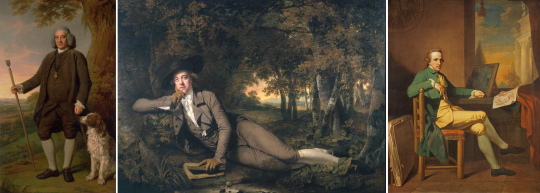
[Left: Thomas ‘Sense’ Browne, oil on canvas, c. 1775, by Nathaniel Dance-Holland, photo credit: Yale Center for British Art, via Art UK.
Middle: Sir Brooke Boothby, oil on canvas, c. 1781, by Joseph Wright of Derby, photo credit: Tate, via Art UK.
Right: David Allan, oil on canvas, c. 1770, by David Allan, photo credit: Royal Scottish Academy/National Galleries of Scotland (Antonia Reeve), via Art UK.]
Stede’s collars are inconstant some are rounded but others are turned down and Ed’s purple suit has a standing collar. Many of Stede’s coats have wide cuffs, but most have little skirt to them. His teal suit from the pilot has a bit of a skirt but its paired with a short waistcoat.

Most of Stede’s waistcoats are short with the exception of his suits from both the wedding portrait with Mary and the the family portrait. Both suits are very straight giving him a boxy appearance and are pretty different from most of the suits we see him in.

All in all I don’t think they were aiming for historically realistic clothes but with the collars, short waistcoats, and lack of skirts I get more of a late-18th century vibe.
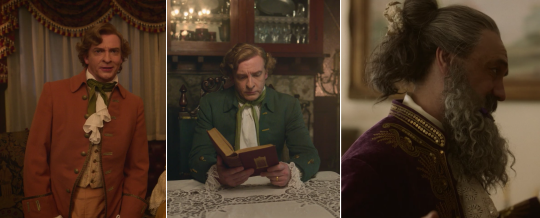
So what was a Macaroni?
A Classical Dictionary of the Vulgar Tongue (1785), defined macaroni as follows:
An Italian paste made of flour and eggs; also a fop, which name arose from a club, called the maccaroni club, instituted by some of the most; dressy travelled gentlemen about town, who led the fashions, whence a man foppishly dressed, was supposed a member of that club, and by contraction stiled a maccaroni.
The macaroni club was said to have comprised of young men who had gained a taste for French and Italian textiles on their Grand Tour (a traditional trip taken tough Europe by upper class men when they came of age). The earliest reference to the club is from a letter from Horace Walpole to Lord Hertford on the 6th Feb 1764:
at the Maccaroni Club (which is composed of all the travelled young men who wear long curls and spying-glasses),
In his book Pretty Gentleman: Macaroni Men and the Eighteenth-Century Fashion World Peter McNeil suggest the club was actually Almack’s. Almack’s was a private club at 50 Pall Mall that was attended by prominent Whigs including Sheridan, Fox and the Price of Wales. (p52) While the name may have originated from the men at Almack’s it was soon used to describe any man who followed the associated fashion trends.
So what were these trends?
Hair
“Still lower let us fall for once, and pop
Our heads into a modern Barber’s shop;
What the result? or what we behold there?
A set of Macaronies weaving hair.”
~ The Macaroni by Robert Hitchcock
Probably the most iconic aspect of macaroni fashion was the hair. “It was the macaroni attention to wigs that caused most consternation” explains Peter McNeil. The macaroni hair “matched the towering heights of the female coiffure, with a tall toupee cresting at the centre front. The wig generally had a long tail at the neck (’queue’), which when folded double was called the ‘cadogan’, all of which required regular dressing with pomade and powder, sometimes in the colours of pink, green or red.” (p45)
The height of the macaroni hair was a point of particular fascination in macaroni caricature exaggerating it beyond what the macaroni were probably actually wearing. Compare below Tom’s hair in the satirical print What is this my son Tom to the self portrait of Richard Cosway, who was satirised by Mary Darly as “The Miniature Macaroni” (a reference both to his height and his career as a miniature painter).
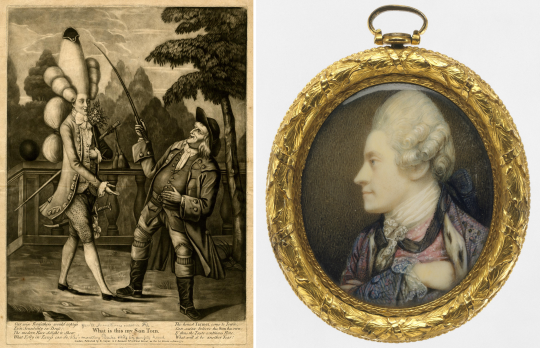
[Left: What is this my son Tom, print, c. 1774, published by Sayer & Bennett, via The British Museum.
Right: Self-Portrait, Ivory, c. 1770–75, by Richard Cosway, via The Met.]
The way Stede usually wears is hair is not particularly macaroni nor particularly 18th century for that matter. The exception to this is his wig from The Best Revenge Is Dressing Well though even this doesn’t have the iconic macaroni hight.

Interestingly both Stede and Ed are wearing flowers in their hair. While there are certainly depictions of women with flowers in there hair I’m not aware of this being a trend in mens fashion at all. However macaroni were known for wearing large nosegays.
While the tall hair was certainly iconic not all macaroni wore their hair tall. Joseph Banks, who was satirised as “The Fly Catching Macaroni” by Matthew Darly, is depicted in his portrait with a fairly typical 18th century hairstyle. Its not the hair alone that makes a macaroni, it was just one aspect of the fashion.
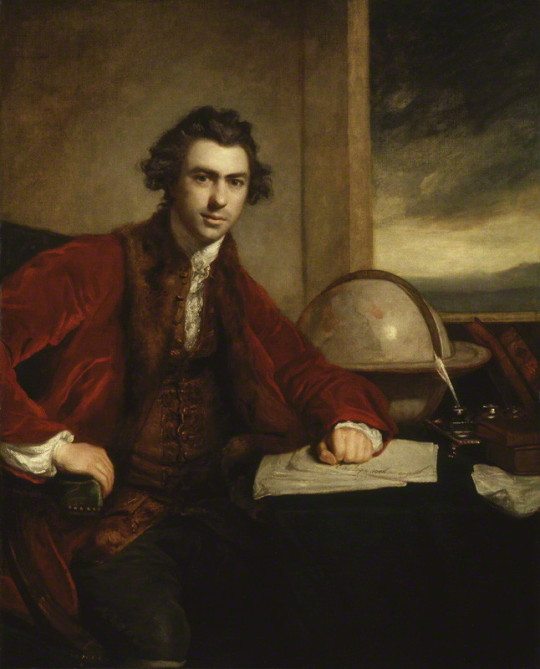
[Sir Joseph Banks, oil on canvas, c. 1771-1773, by Sir Joshua Reynolds, via Wikimedia.]
Suit
“If I went to Almack’s and decked out my wrinkles in pink and green like Lord Harrington, I might still be in vogue.” ~ Horace Walpole to Lord Hertford, 25 Nov 1764
Menswear of the period consisted of the same basic elements; shirt, stockings, breeches, waistcoat and coat. What differentiated the macaroni from others was the fabric, cut, colour and trimmings of the suit. “At a time when English dress generally consisted of more sober cuts and the use of monochrome broadcloth,” explains Peter McNeil “macaronism emphasised the effects associated with French, Spanish and Italian textiles and trimmings”. Popular amongst macaroni were brocaded and embroidered silks and velvets, sometimes further embellished with metallic sequins, simulated gemstones and raised metallic threads. Popular colours included pastels, pea-green, pink, red and deep orange. (McNeil, p30-32)
Far from wearing “monochrome broadcloth” Stede likes a “fine fabric” and dresses in a range of colours, we see him in teal, pink, purple, green, white, red, peach &c.
Tightly cut French style suits known as habit à la française were popular with macaroni. (McNeil, p14) Stede’s suits vary somewhat in cut but some are very French. The peach suit Stede wears in We Gull Way Back particularly has a very macaroni feel to me. Compare it to the English suit (left) and the French suit (right).

From the back you can see the English suit has more of a skirt to it.

Both Stede’s suit and the French suit are somewhat plain but have been paired with a floral embroidered waistcoat, while the English suit has a matching plain black waistcoat.
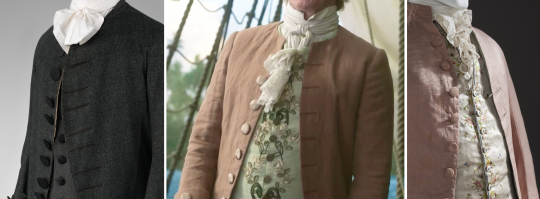
[Left: English suit, wool, silk, c. 1755–65, via The Met, number: 2009.300.916a, b.
Right: French suit, Silk plain weave (faille), c. 1785, via LACMA, number: M.2007.211.47a-b.]
Fabric covered button’s were common in the 18th century, you can see them on both the French and English coats above. In contrast Stede wears a lot of metal buttons. Steel buttons were popular amongst macaroni, a trend that was satirised in Steel Buttons/Coup de Bouton.

[Steel Buttons/Coup de Bouton, print, c. 1777, by William Humphrey, via The British Museum.]
Pumps and Parasols
“Maccaronies who trip in pumps and with Parasols over their heads” ~ Mrs Montagu
High heels had been popular amongst men during the 17th century. The Royal Collection Trust explains:
In the first half of the 17th century, high heeled shoes for men took the form of heeled riding or Cavalier boots as worn by Charles I. As the wearing of heels filtered into the lower ranks of society, the aristocracy responded by dramatically increasing the height of their shoes. High heels were impractical for undertaking manual labour or walking long distances, and therefore announced the privileged status of the wearer.
(Royal Collection Trust, High Heels Fit for a King)
In 17th century France Louis XIV popularised red-heels by turning them into a symbol of political privilege, which in turn spread the fashion to England. But with the sobering of menswear in England around the turn of the century the high heel and the red-heels went out of fashion. (see Bata Shoe Museum Toronto, Standing TALL: The Curious History of Men in Heels)
The high heel had a bit of a resurgence in the 1770s with macaroni fashion. The Natural History of a Macaroni snipes that the macaroni’s “natural hight is somewhat inferior to he ordinary size of men, through by the artificial hight of their heels, they in general reach that standard”. (Walker’s Hibernian Magazine, July 1777, p458)
Red-heels were reintroduced to England by young men returning from their Grand Tours. A young Charles James Fox (satirised by Mathew Darly as “the Original Macaroni”) wore such French style red-heeled shoes. The Monthly Magazine recalls a young Fox as a “celebrated “beau garçon” with “his chapeau bras, his red-heeled shoes, and his blue hair-powder.” (Oct 1806) and The Life of the Right Honorable, Charles James Fox recalls him in his “suit of Paris-cut velvet, most fancifully embroidered, and bedecked with a large bouquet; a head-dress cemented into every variety of shape; a little silk hat, curiously ornamented; and a pair of French shoes, with red-heels;” (p18) And in Recollections of the Life of the Late Right Honorable Charles James Fox B.C. Walpole recalls him as “one of the greatest beaus in England,” who “indulged in all the fashionable elegance of attire, and vied, in point of red heels and Paris-cut velvet with the most dashing young men of the age. Indeed there are many still living who recollect Beau Fox strutting up and down St. Jame’s-street, in a suit of French embroidery, a little silk hat, red-heeled shoes, and a bouquet nearly large enough for a may-pole.” (p24)
Compare the French style red-heeled shoes of Louis XIV to Stede’s red-heeled shoes.

[Left: detail of Louis XIV, oil on canvas, c. 1701, by Hyacinthe Rigaud, via Wikimedia.]
However most macaroni were depicted wearing the more standard late 18th century low-heeled bucked shoes. Where they distinguished themselves was the size and decoration of the buckles. “Such buckles could be set with pate (lead glass) or ‘Bristol stones’ (chips of quartz), or diamonds if you were very rich.” Explains peter McNeil, “The new macaroni fashion was for huge silver or plated Artois shoe buckles which the Mourning Post claimed weighed three to eleven ounces.” (p90)
While certainly not as iconic has his heels Stede also wears these sorts of shoes. Compare below the shoes from a macaroni caricature to Ed wearing Stede’s shoes (I couldn’t get a good shot of Stede wearing them).

[Left: detail of How d'ye like me, print, c. 1772, published by: Carington Bowles, via The British Museum.]
“A great many jewelled accessories accompanied the macaroni look”, writes Peter McNeil, “They included hanger swords, very long canes, clubs, spying glasses and snuff-boxes.” (p68) Tragically we don’t see Stede with a fashionable dress sword or a cane but we do see him with another accessory popular amongst macaroni; a parasol.
Popular in France parasols/umbrellas were adopted by the macaroni. They were popular amongst both men and woman in France but in England they had a feminine connotation. (McNeil, p129) In the 1780s as umbrellas became more popular amongst men there was a cultural pushback to the perceived gender transgression. On the 16th of August 1780 the Morning Post complains of of the “canopy of umbrellas” bemoaning that “the effeminacy of the men, inclines them to adopt this necessary appendage of female convenience”. On the the 4th Oct, 1784, the Morning Chronicle published a letter complaining of “that vile foppish practice of sheltering under a umbrella”. The author of this tirade writes that while “the ladies should be allowed to secure their beauty and persons from the heat of the sun, or the inclemency of the weather,” because “it is natural, and has a striking effect”, that “to see a great lubberly cit, bounce from his shop, with a coat, hat, and wig that are not together worth one groat,” sheltering “from the influence of the solar beam” was “intolerable.” However:
The macaroni being of the doubtful gender, may in part claim a feminine right; his dress is too delicate to bear an heavy shower, perhaps his person is so too; but a coach, if a clean one is to be found would serve his purpose much better, as there would be less likelihood of his being washed away into the kennel, which he deserves to be kicked into for his d-----d affectation.

Wealth
Born from rich young men returning from their tours with a taste for French and Italian textiles macaroni fashion was expensive. Certainly a working class man would not be able to afford Stede’s wardrobe. Both the sheer amount of clothes he has as well has the fabrics those clothes are made of are indications of wealth. However to say that Stede’s wardrobe is only an indication of wealth would be missing part of picture.
Most rich upper class English men (including colonial) wore plain monochrome suits. Even amongst the gentry macaroni fashion was not the norm. Compare bellow George Washington (left) who was a wealthy planation owner, but notably not a macaroni, to Richard Cosway (right) who was a famous macaroni.

[Left: George Washington, oil on canvas, c. 1796, by Gilbert Stuart, via Pennsylvania Academy of the Fine Arts.
Right: Detail of The Academicians of the Royal Academy, oil on canvas, c. 1771-72, by Johan Zoffany, via The Royal Collection Trust.]
In spite of the expense macaroni fashion was not exclusive to the upper classes. “Macaroni dress was not restricted to members of the aristocracy and gentry,” writes McNeil, “but included men of the artisan, artist, and upper servant classes, who wore versions of this visually lavish clothing with a distinctive cut and shorter jackets. Wealthier shopkeepers and entrepreneurs also sometimes wore such lavish clothing, particularly those associated with the luxury trades, such as mercers and upholsterers -” (p14)
It was possible to copy certain aspects of macaroni fashion on a cheeper budget. The hairstyle in particular was achievable without braking the bank. And there were ways to replicate the effects of certain expensive fashion trends for cheeper prices. For example patterns could be printed rather than embroidered.

[Left: printed waistcoat, cotton, c. 1770–90, via The Met, number: 35.142.
Right: embroidered waistcoat, silk, c. 1780–89, via The Met, number: 2009.300.2908.]
The Town and Country Magazine complains “we now have Macaronies of every denomination, from the colonel of the Train’s-Bands down to the errand-boy.” (McNeil, p169) The Morining Post mocks macaronies that couldn't financially keep up with the trends:
The macaronies of a certain class are under peculiar circumstances of distress, occasioned by the fashion, now so prevalent, of wearing enormous shoe-buckles; and we are well assured that the manufactory of plated ware was never known to be in so flourishing a situation.
(14 Jan, 1777)
In 18th century England, class was about more than just how much money you had. It was about pedigree. “English society was particularly alert to those whom it felt were using clothes to achieve a social status they did not merit” explains McNeil. Richard Cosway was a famous macaroni from modest background. Born to a Devonshire headmaster he was sent to London to study painting at 12. He became a very successful miniature painter and grew rich from the patronage of the Prince of Wales (later George IV) and Whig circles. In Nollekens and his Times J.T. Smith writes of Cosway:
He rose from one of the dirtiest boys, to one of the smartest of men. Indeed so ridiculously foppish did he become that Mat Darly, the famous caricature print-seller, introduced an etching of him in his window in the Strand, as ‘The Macaroni Miniature Painter’
(McNeil, p105-14)
But it was not only the Darlys that satirised Cosway Hannah Humphrey mocks Cosway as a social climber in A Smuggling Machine or a Convenient Cos(au)way for a Man in Miniature which depicts him standing under the petticoats of his much taller wife Maria. In the background there is a picture of Cosway climbing a ladder that rests upon a woman (she is believed to either be Angelica Kauffman or the Duchess of Devonshire). Below this reads:
Lowliness is Young Ambitions Ladder,
Whereto the climber upward turns his Face
But when he once attains the upmost round
He then unto the Ladder turns his back,
Looks unto the clouds - scornin [sic] the base degrees
By which he did assend.
Shak. Jul. Caesar.

[A Smuggling Machine or a Convenient Cos(au)way for a Man in Miniature, print, c. 1782, by Hannah Humphrey, via The British Museum.]
Another famous macaroni not born into the aristocracy was Julius Soubise. Brought to England from the West Indies as a slave he was taken in by Catherine Hyde, the Duchess of Queensbury. She gave him a leisured childhood, in which he was taught to play and compose for the violin, was taught to fence by Domenico Angelo, and learned oration from David Garrick. “Macaroni caricatures of Soubise parodied a foppish upstart whose outfits and entertainments, financed by the Duchess, affronted both racial and social expectations of an African male.” Writes Petter McNeil, Soubise was satirised as “a Mungo Macaroni” an “offensive term meaning a rude or forward black man.” (p118)
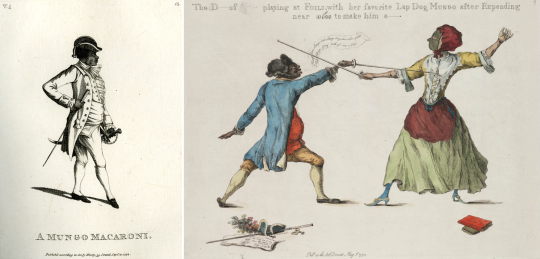
[Left: A Mungo Macaroni, print, c. 1772, by Matthew Darly, via The British Museum.
Right: The D------ of [...]-- playing at foils with her favorite lap dog Mungo after expending near £10000 to make him a----------*, print, c. 1773, by William Austin, via Yale Center for British Art.]
The expense of Stede’s wardrobe is a key part of the narrative. Stede has nice fancy luxurious things. Ed wants nice fancy luxurious things. Ed was born a poor brown boy and while he may be rich now he can never truly change his class. He could be as rich as Richard Cosway or Julius Soubise but to the gentry he will always be that poor brown boy.

Gender
As we have already seen in the tirade against men using umbrellas the macaroni was perceived as being of “the doubtful gender”. (The Morning Chronicle, 4 Oct, 1784)
The Natural History of a Macaroni writes that there “has within these few years past arrived from France and Italy a very strange animal, of the doubtful gender, in shape somewhat between a man and monkey,” that dresses “neither in the habit of a man or woman, but peculiar to itself”. The author states that “they are in no respect useful in this country”:
that the minister of the war department would give orders to have them enlisted for the service of America: we do not mean to put them on actual duty there. Alas! they are as harmless in the field, as they are in the chamber, but they may stand as faggots to cover the loss of real men.
(Walker’s Hibernian Magazine, July 1777, p458-9)
A “faggot” being “A man who is temporarily hired as a dummy soldier to make up the required number at a muster of troops, or on the roll of a company or regiment.” (see OED)

[The Masculine Gender & The Feminine Gender, etching with touches of watercolour, c. 1787, Attributed to Henry Kingsbury, via The Met.]
The macaroni wasn’t just considered effeminate because of the way they dressed but also because of their interests and the way walked and talked. Famous for playing fops and macaroni, the actor David Garrick did a lot to establish the character of the macaroni in the public mind. In his poem The Fribbleriad Garrick mocks the men who were offended by his performances asserting, perhaps accurately, that they were offended because it was them he mocked. He portrays a group of angry effeminate men meeting in order to seek revenge on him for his portrayal of them:
May we no more such misery know!
Since Garrick made OUR SEX a shew;
And gave us up to such rude laughter,
That few, ’twas said, could hold their water:
For He, that player, so mock’d our motions,
Our dress, amusements, fancies, notions,
So lisp’d our words, and minc’d our steps,
The macaroni had become more than simply an effeminate man, he had become a new sex. Something not quite man or woman. Something in-between. A new description of a macaroni asks the question:
Is it a man? ‘Tis hard to say - A woman then
- A moment pray -
So doubtful is the thing, that no man
Can say if ‘tis a man or woman:
Unknown as yet by sex or feature,
It moves - a mere amphibious creature.
(McNeil p169)
Sexuality
Much like today in the 18th century effeminacy was associated with homosexuality. Men who had sex with other men were known as mollies. A Classical Dictionary of the Vulgar Tongue (1785), defined a molly as “A Miss Molly; an effeminate fellow, a sodomite”. In the History of the London Clubs (1709), Ned Ward characterises mollies as follows:
There are a particular Gang of Wretches in Town, who call themselves Mollies, & are so far degenerated from all Masculine Deportment or Manly exercises that they rather fancy themselves Women, imitating all the little Vanities that Custom has reconcil’d to the Female sex, affecting to speak, walk, tattle, curtsy, cry, scold, & mimick all manner of Effeminacy.
“By the 1760′s,” explains Peter McNeil, “too much attention to fashion on the part of a man was read as evidence if a lack of interest in women”. (p152)
Macaroni were often portrayed as incapable or simply uninterested in sexual relations with women. This attitude is expressed by Mr. Bate in the following dialogue from The Vauxhall Affray; Or, the Macaronies Defeated:
Mr. Fitz-Gerall: I always though a fine woman was only made to be looked at.
Mr. Bate: Just sentiments of a macaroni. You judge of the fair sex as you do your own doubtful gender, which aims only to be looked at and admired.
Mr. Fitz-Gerall: I have as great a love for a fine woman as any man.
Mr. Bate: Psha! Lepus tute es et pulpamentum quæris?
Mr. Fitz-Gerall: What do you say, Parson?
Mr. Bate: I cry you mercy, Sir, I am talking Heathen Greek to you; in plain English I say, A macaroni you, and love a woman?
Mr. Fitz-Gerall: I love the ladies, for the ladies love me.
Mr Bate: Yes, as their panteen, their play-thing, their harmless bauble, to treat as you do them, merely to look at
While lack on interest in woman does not necessarily mean attraction to men, Matthew Darly takes the implication there in his 1771 set of macaroni caricatures which induces a print entitled Ganymede, a reference to Zeus’ male lover of the same name. Ganymede is believed to be a parody of Samuel Drybutter who had been arrested for attempted sodomy in January 1770. Darly also includes the character Ganymede in Ganymede & Jack-Catch. Jack-Catch is a reference to the infamous English executioner John Ketch. In the print Jack-Catch says, “Dammee Sammy you’r a sweat pretty creature & I long to have you at the end of my String.” Ganymede replies, “You don’t love me Jacky”. Jack-Catch is holding a noose with one hand and stroking Ganymede’s chin with the other. Jack-Catch is soberly dressed in typical 18th century menswear, while Ganymede’s dress is distinguished by his lace ruffles and styled wig. The print is not only suggesting that macaroni are sodomites but making a joke of the execution of them. The punishment for a sodomy at this time in England being death by hanging.

[Left: Ganymede, print, c. 1771, Matthew Darly, via The Met.
Right: Ganymede & Jack Catch, print, c. 1771, Matthew Darly, via The British Museum]
An anonymous letter to the Public Ledger (5 Aug, 1772) says blatantly what others had already implied. “The country is over-run with Catamites, with monsters of Captain Jones’s taste, or, to speak in a language witch all may understand, with MACCARONIES”. The writer warns macaroni who have “escaped detection” as sodomites and “therefore cannot fairly be charged” that they have not avoided suspicion:
Suspicion is got abroad-the carriage-the deportment-the dress-the effeminate squeak of the voice-the familiar loll upon each others shoulders-the gripe of the hand-the grinning in each others faces, to shew the whiteness of the teeth-in short, the manner altogether, and the figure so different from that of Manhood, these things conspire to create suspicion; Suspicion gives birth to watchful observation; and, from a strict observance of the Maccaroni Tribe, we very naturally conclude that to them we are indebted for the frequency of a crime which Modesty forbids me to name. Take warning, therefore, ye smirking group of Tiddy-dols: However secret you may be in your amours, yet in the end you cannot escape detection;
Bows on His Shoes
18th century shoes were typically buckled, laces and ribbons were simply unfashionable. As mentioned previously macaroni were distinguished by the size and decoration of the buckles. So are Stede’s bows simply ahistorical? Well there are references to 18th century men wearing laces and ribbons.
Towards the end of the 18th century laces started to come into fashion. Appeal from the Buckle Trade of London and Westminster, to the Royal Conductors of Fashion (1792) complained that despite how “tender and effeminate the appearance of Shoe Strings” the “custom of wearing them has prevailed.”
Perhaps the most intriguing reference is that of Commissioner Pierre Louis Foucault’s papers where he details the surveillance, investigation and entrapment of "pederasts” in Paris. It is important to note that the word “pederasty” was used synonymously with “sodomy” in the 18th century and did not denote age simply sex. An Universal Etymological English Dictionary (1726) defines “A pederast” as “a Buggerer” and “Pederasty” as “Buggery”.
Foucault and the men working with him identified particular clothing worn by men seeking sex with other men that he called the “pederastical uniform”. In Foucault’s papers men are described as being “attired in such a way as to be recognized by everyone as a pederast”, “clothed with all the distinctive marks of pederasty”, or simply “dressed like a pederast”. This “uniform” generally included “some combination of frock coat, large tie, round hat, small chignon, and bows on the shoes.” Jeffrey Merrick in his article on Foucault speculates that these men dressed this way to signal to each other. However when questioned by police they would understandably deny such a purpose, one man when questioned about his outfit responded that everyone “dresses as he sees fit”. (Jeffrey Merrick, Commissioner Foucault, Inspector Noël, and the “Pederasts” of Paris,1780-3)
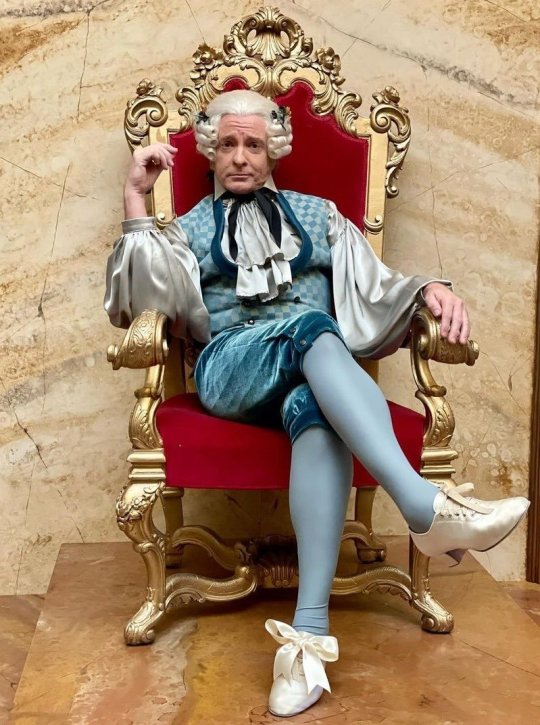
Conclusion
I’m not saying Stede is intended to be a macaroni. If that were the case they would have given him the iconic macaroni hairstyle. However the costuming team has clearly pulled from fashion trends that were associated with effeminacy and homosexuality. While OFMD is evidently wholly unconcerned with creating period accurate costumes the costumes are still clearly inspired by historical fashions. Perhaps the curtains really are just blue but maybe Stede wears bows on his shoes because he’s gay.
#I had way too much fun doing this#our flag means death#ofmd meta#stede bonnet#queer history#macaroni#historical fiction#fashion history
195 notes
·
View notes
Note
hi!!! i would love some help finding a 25+ faceclaim that would act as an older sibling to a sharon alexie faceclaim! the setting is dark academia, so if they can also match those general vibes, that would be awesome but not required. thank you so much!!

𝙝𝙞 𝙗𝙖𝙧𝙗𝙞𝙚! ooh sharon alexie is so gorgeous. and dark academia, fun!! i hope this is helpful for you, angel ♡
Andre Holland ( 1979, actor )
Bethany Antonia ( 1997, actress )
BJ Britt ( 1982, actor )
Chris Chalk ( 1977, actor )
Diamond White ( 1999, actress )
Elle Lorraine ( age unknown, actress )
Janelle Monae ( 1985, musician with acting roles, non-binary )
Javicia Leslie ( 1987, actress )
Jeremy Pope ( 1992, actor )
Nafessa Williams ( 1989, actress )
Nanna Blondell ( 1986, actress )
Omar Sy ( 1978, actor )
Rachel Hilson ( 1995, actress )
Sonequa Martin-Green ( 1985, actress )
Stephan James ( 1993, actor )
Wakeema Hollis ( 1984, actress )
Zaraah Abrahams ( 1987, actress )

#rph#black fc#underused male fc#underused female fc#underused faceclaim#underused fc#poc fc#bipoc fc#dark academia rp#academia rp#college rp#older fc#mature muse rp#mature rp#answered: fc help#answered: anonymous#answered#five nights at freddi's: mascot post
15 notes
·
View notes
Text



Title: Be Told
WC: 900
“Why you gotta ruin the dream?”
—Richard Castle, One Man’s Treasure (2 x 10)
It really does sound dirtier than he meant it. He only meant to needle her with a backhanded compliment and wag of the eyebrows, but he really didn’t mean for it to sound that dirty. That’s . . . rather a shock to the system, how the truth slips right out of his mouth. He tells himself she hasn’t noticed—or that she takes the admission as a lie, which is just as good as her not noticing, isn’t it? Either way, his charmingly caddish, pleasantly salacious image is intact, so no harm done.
He’s not really convinced. He’s about as convinced as she was, judging from the what the hell? look she’d given him before the next element of the case had mercifully swooped in to save him—possibly to save both of them—from this version of himself, the one who does not intend to double every possible entendre.
He has the sinking feeling that there’s no saving anyone from this . . . outbreak of sincerity. But that doesn’t mean he doesn’t try to explain it away. He starts by invoking Coco Chanel. This case has had him hitting the cad button hard as he celebrates every clichéd aspect of Sam Parker/Jake Holland’s scam. Even he can admit that his performative glee at the eleventh hour possibility that the man had been juggling a third relationship before his death had been a bit over the top. So perhaps the unexpected truth was simply the equivalent of removing one accessory before he left the house, as it were.
But he can put himself down as “not particularly convinced” on that front, too. For one thing, the way he’d gone after Sarah Reed/Laura Branson in the interrogation—the way he’d delighted in letting her know she’d been made and played—had marked him as clearly, enthusiastically, and maybe even a little bit pathetically team Sam/Jake.
And why, exactly, is that, he wonders? On the surface, their crimes are equivalent. He never loved her, she never loved him, et cetera, et cetera. Theoretically, there’s some relevant aphorism about geese and ganders that should map on to James Bond and Mata Hari or something.
There’s a desperate moment when he tries to convince himself that he’s reacting to the fact of Sarah/Laura’s surprise six-year-old—that he’s whipsawed from lamely trying to reassure the woman that Sam/Jake might have loved her to wanting to strip her of every illusion regarding her professional bad-assery. He tries to conjure the most Dickensian image he can of the presumably fatherless inconvenience Sarah/Laura had to tuck away somewhere fairly frequently. But he doesn’t know any of that for certain—she might be a perfectly successful coparent and a professional liar. And it’s not as though Sam/Jake wasn’t all but abandoning his two kids so he could go play corporate spy.
There’s the dismal possibility that he’s not just a cad, he’s a cad with double standards, and that’s not exactly charming. There’s nothing pleasant about it, is there?
Even this late in the game, he’d like to think it’s something like the anti-Coco principle. Going for their Mata Hari’s throat comes after his brush with sincerity, so perhaps he’s just compensating. Or perhaps it’s even simpler than that. This might be a case of another missed mark, as his mother would say, and today is simply not going to go down in history as one of his better performances.
But he finds himself right back in Unconvinced, population him, once again. There’s something else going on with him—something this case is bringing uncomfortably to the surface.
He has a flailing, unclear sense that it has something to do with Alexis being on the fringes of of all this, diligently working, unsurprisingly taking on a compassionate mission along the way.
He is aware on some level that he is less okay with the sudden overlap between his two worlds than he would like to be. He would like to be purely proud and pleased that his daughter is interested in the work he is doing here. He would like to be able to tell her outright that he’s proud of both her and this work in which he’s found unexpected meaning He would like to be grateful, without complications, that Beckett has been so generous with not just her time, but such warm approval. He’d like to thank her—truthfully, sincerely—for making his daughter light up like that.
But he’s nervous, truth be told. He’s in unknown territory with this young woman who, he feels certain, was a little girl just yesterday. The rules of engagement on the home front are changing minute-by-minute, and he counts on things being just so at the precinct. He counts on hitting his marks, knowing his lines, and never missing a beat. And now he seems to be losing the thread of who he actually is and who it is he pretends to be, because this is their dynamic—his and Beckett’s: He is the cad, she is the long-suffering straight arrow, cursed to have him tagging along, breaking into applause for his fellow rogues and running a cottage industry in innuendo.
Truth be told, he’s more than nervous, he’s afraid. He strongly suspects his cover has been blown. He’s the one who blew it in a moment of unexpected truth: That sounded dirtier than I meant it.
A/N: Wut? What a weird one, Brain Poneh; but I was struck by Castle's nerves about Alexis and the way he's a bit too hung ho about some of the scam elements, both in terms of admiring Sam/Jake and going after Sarah/Laura
images via homeofthenutty
#Castle#Caskett#CastleABC#Castle: Season 2#Castle: One Man's Treasure#Castle: 2 x 10#Kate Beckett#Richard Castle#Johanna Beckett#Lanie Parish#Alexis Castle#Martha Rodgers#Roy Montgomery#Javier Esposito#Kevin Ryan#Jim Beckett#Fic#Fanfic#Fanfiction#Fan Fic#Fan Fiction#Writing#Fabrications
17 notes
·
View notes